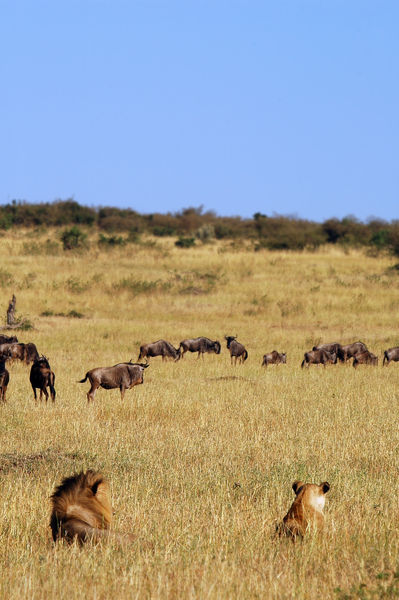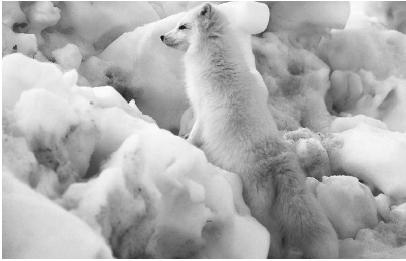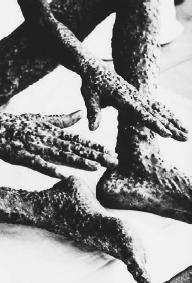Biological Communities - Real-life applications

Competition
The word competition typically brings to mind images of a basketball court or football field, on one hand, or a Wall Street trading floor or board-room, on the other. In biological terms, however, competition is the interaction among organisms of the same or different species vying for a common resource that appears in a limited supply relative to the demand. Put another way, this means that the capability of the environment to supply resources is smaller than the potential biological requirement for those resources.
Scarcity of resources relative to the need for them is one of the governing facts of human life, reflected in such common expressions as "There is no such thing as a free lunch." In fact, humans have spent most of their history in a modified form of biological competition, war. Furthermore, it may well be that our modern predilection for sports or business competition is simply a matter of transforming biological competition into a more refined form. In any case, competition prevails throughout the world of living things.
INTRASPECIFIC AND INTER-SPECIFIC COMPETITION.
For example, plants often compete for access to a limited supply of nutrients, water, sunlight, and space. Intraspecific competition occurs when individuals of the same species vie for access to essential resources (later we look at intraspecific competition between humans), or for mating partners, whereas interspecific competition takes place between different species.
Individuals of the same species have virtually identical resource requirements: for example, all humans need food, water, air, and some protection from the natural elements. For this reason, whenever populations of a species are crowded together, intraspecific competition is intense. This also has been illustrated by experiments involving laboratory mice, which become increasingly brutal to one another when confronted with severely diminished resources. When intraspecific competition occurs in dense populations, the result is a process known as self-thinning, characterized by the mortality (death) of those individuals less capable of surviving coupled with the survival of individuals that are more competitive. If this sounds like the "survival of the fittest," an idea associated with evolution that became the justification for a number of nefarious social movements and activities (see Evolution), it is no accident.
Ideas related to intraspecific competition influenced the English naturalist Charles Darwin (1809-1882) in developing his theory of evolution by means of natural selection. Intraspecific competition is an important regulator of population size and can make the species as a whole more fit by ensuring that only the hardiest individuals survive. Likewise, interspecific competition, or competition between species, plays a

COMPETITIVE RELEASE.
Environmental changes that affect a biological community may change the competitive relationships within it, leading to interesting results. During the early 1950s, a fungal pathogen (a disease-carrying parasite in the form of a fungus) known as chestnut blight, or Endothia parasitica, ended the dominance of the American chestnut in the eastern United States. Up to that time, the American chestnut ( Castanea dentata ) had been the leading species in the canopy, or uppermost layer, of the deciduous (prone to seasonal shedding of leaves) forests in the region. Thanks to the chestnut blight, it was as though the winner had been disqualified from a race, meaning that all the runners-up changed their standings.
By being relieved of the stresses associated with competition, other trees were allowed to become more successful and dominant in their habitat. They took advantage of this change to fill in the canopy gaps left by the demise of mature chestnut trees. In the same way, if a wildfire, storm, or other stress disturbs a mature forest, plants that previously have been suppressed by the higher-canopy trees find themselves with much greater access to such resources as light, moisture, and nutrients. As a result, they thrive.
Given the distasteful aspects of biological competition, such as the destruction of the "weak" in favor of the "strong" (actually, less adapted and more adapted are much more accurate terms in this context), one might wish for a situation in which no competition exists. Indeed, there are such situations in nature, but they are far from pleasant. In such biomes as the arctic tundra, for instance, competition is low, but this is not because all nature lives in happiness and harmony; instead, organisms face such powerful environmental stresses from the local climate that competition is not the most significant factor limiting populations.
THE TUNDRA BIOLOGICAL COMMUNITY.
Creatures on the tundra face little stress from competition, but a great deal of stress in the form of very short growing seasons, thin soil, limited ground cover, low average temperatures and rainfall, high winds, and so on. If the density of individual plants of the tundra is decreased experimentally by thinning, the residual plants do not thrive as a result, as they might in a less harsh climate. In the case of the tundra, it is not competition that constrains their productivity, and therefore the reduction of potential competition does little to improve conditions for the organisms that survive.
It is interesting to observe what happens in a tundra environment if the intensity of environmental stress is artificially and experimentally alleviated by enclosing an area under a greenhouse and by fertilizing it with nutrients. Such experiments have been performed, and the results are fascinating: under these more favorable environmental conditions, competition actually increases, resulting in a biological community not unlike that of a more hospitable biome.
Biological Communities and Civilizations
In his best-seller Guns, Germs, and Steel: The Fate of Human Societies, ethnobotanist Jared M. Diamond showed that local biological communities are among the leading determinants of the success or failure of human civilizations. The book had its beginnings, he wrote, during his many years of work with the native peoples of New Guinea. One day, a young man put a simple question to him: why do the societies of the West enjoy an abundance of material wealth and comforts, while those of New Guinea have so little?
The question may have been simple, but the answer was not obvious. As a scientist, Diamond refused to give an answer informed by the politics of the Left or Right, which might have blamed the problem, respectively, on western exploitation or on the failures of the New Guineans themselves. Instead, he approached it as a question of environment, and the result was his thought-provoking analysis, contained in Guns, Germs, and Steel.
FAVORABLE AND UNFAVORABLE ECOSYSTEMS.
As Diamond showed, the places where agriculture was born were precisely those blessed with favorable climate, soil, and indigenous plant and animal life. Of course, it is no accident that civilization was born in the societies where agriculture first developed. Before a civilization can evolve, a society must become settled, and for that to happen, it must have agriculture.
Agriculture came into existence in four places during a period from about 8000 to 6000 B.C. In roughly chronological order, these locations were Mesopotamia, Egypt, India, and China. All were destined to emerge as civilizations, complete with written language, cities, and organized governments, between about 3000 and 2000 B.C.
In the New World, by contrast, agriculture appeared much later and in a much smaller way. The same was true of Africa and the Pacific Islands. In seeking to find the reasons why this happened, Diamond noted a number of factors, including geography. The agricultural areas of the Old World were stretched across a wide area at similar latitudes. This meant that the climates were not significantly different and would support agricultural exchanges, such as the spread of wheat and other crops from one region or ecosystem to another. By contrast, the landmasses of the New World or Africa have a much greater north-to-south distance than they do east to west, resulting in great differences of climate.
DIVERSITY OF SPECIES.
Today such places as the American Midwest support abundant agriculture, and one might wonder why that was not the case in the centuries before Europeans arrived. The reason is simple but subtle, and it has nothing to do, as many Europeans and their descendants believed, with the cultural "superiority" of Europeans over Native Americans. The fact is that the native North American biological communities were far less diverse than their counterparts in the Old World. Peoples of the New World successfully domesticated corn and potatoes, because those were available to them. But they could not domesticate emmer wheat, the variety used for making bread, when they had no access to that species (it originated in Mesopotamia and spread throughout the Old World).
The New World also possessed few animals that could be domesticated either for food or for labor. Every single plant or animal that is a part of human life today had to be domesticated—adapted in such a way that it becomes useful and advantageous for humans—and the range of species capable of domestication is far from limitless. In fact, it is safe to say that all major species capable of being domesticated have been, thousands of years ago. The list of animals that can be domesticated is a short one, much shorter than the list of animals that can be tamed. A bear, for instance, can be captured, or raised from birth in captivity, but it is unlikely that humans would ever be able to breed bears in such a way that

The animals that helped make possible the development of farms, villages, and ultimately empires in the Old World—cows and oxen, horses and donkeys, sheep and so on—were absent from the New World. (Actually, horses had once existed in the Americas, but they had been destroyed through overhunting, as discussed in the context of mass extinction within the Paleontology essay.) Many Indian tribes domesticated some types of birds and other creatures for food, but the only animal ever adapted for labor—by the most developed civilization of the pre-Columbian Americas, the Inca—was the llama, which is too small to carry heavy loads.
GREATER EXPOSURE TO MICROORGANISMS.
The Europeans' advantage over the Native Americans derived ultimately from the ecological complexity of their biological communities compared with those of the Native Americans. This was also true of the "biological communities" they could not see, and of which people were unaware in 1500: the world of microorganisms, or the "germs" in the title of Diamond's book.
The native peoples of the New World had no natural resistance to smallpox or a host of other diseases, including measles, chicken pox, influenza, typhoid fever, and the bubonic plague. As with many plants and animals of the Old World, they simply had no exposure to these microorganisms. In the Old World, however, close contact with farm animals exposed humans to diseases, as did close contact with other people in crowded, filthy cities. This exposure, of course, killed off large numbers in such plagues as the Black Death (1347-1351), but those who survived tended to be much stronger and possessed vastly greater immunities. Therefore, the vast majority of Native American deaths that followed the European invasion were not a result of warfare, enslavement, or massacre of villages (though all of these occurred as well), but of infection. (See Infection and Infectious Diseases for more on these subjects.)
CANNIBALISM.
Even the practice of cannibalism in such remote locations as the New Guinea highlands is, according to Diamond, a consequence of a relatively limited biological community. In the past, westerners assumed that only very "primitive" societies engaged in cannibalism. However, events have shown that, when faced with starvation, even people from European and European-influenced civilizations may consume human flesh in order to survive.
For instance, in 1846 members of the Donner party, making the journey west across North America, resorted to eating the bodies of those who had died in the perilous crossing. Much the same happened in the 1970s, when a plane carrying Uruguayan athletes crashed in the Andes, and the survivors lived off the flesh of those who had died. Though their upbringing and cultural norms may have told them that cannibalism was immoral or at the very least disgusting, their bodies told them that if they did not consume the only available food, they would die.
Whereas these circumstances were unusual and temporary, peoples in some parts of the world have been faced with a situation in which the only sources of protein provided within the biological community are ones whose consumption seems repugnant from the western viewpoint. Discussing the New Guinea highlands, Diamond noted that the area is virtually bereft of protein sources in the form of large, nonhuman mammals. Nor is bird life sufficient to support the local populace, and marine food sources are far away. For this reason, natives are prone not only to cannibalism but also to another culinary practice that most westerners find appalling: eating bugs, worms, grubs, caterpillars, and other creepy-crawly creatures.
WHERE TO LEARN MORE
Biota.org : The Digital Biology Project (Web site). <http://www.biota.org/> .
DeLong, J. Bradford. "Review of Diamond ," Guns, Germs, and Steel (Web site). <http://econ161.berkeley.edu/Econ_Articles/Reviews/diamond_guns.html> .
"Designing a Report on the State of the Nation's Ecosystems." U.S. Geological Survey, Biological Resources Division (Web site). <http://www.us-ecosystems.org/index.html> .
Diamond, Jared M. Guns, Germs, and Steel: The Fates of Human Societies. New York: W. W. Norton, 1997.
Living Resources and Biological Communities (Web site). <http://www.chesapeakebay.net/ecointr5.htm> .
Miller, Kenton, and Laura Tangley. Trees of Life: Saving Tropical Forests and Their Biological Wealth. Boston: Beacon Press, 1991.
Nebel, Bernard J. Environmental Science: The Way the World Works. Englewood Cliffs, NJ: Prentice Hall, 1990.
NMITA: Neogene Marine Biota of Tropical America (Web site). <http://porites.geology.uiowa.edu/> .
Patent, Dorothy Hinshaw. The Vanishing Feast: How Dwindling Genetic Diversity Threatens the World's Food Supply. San Diego: Harcourt Brace, 1994.
Plant Communities of California (Web site). <http://encenter.org/habitat/habitatcontent.html> .
Quinn, John R. Wildlife Survivors: The Flora and Fauna of Tomorrow. Blue Ridge Summit, PA: TAB Books, 1994.
Comment about this article, ask questions, or add new information about this topic: